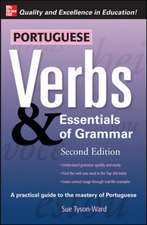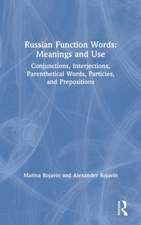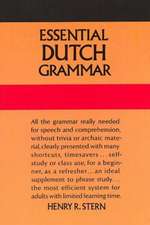Russian Nouns of Common Gender in Use
Autor Marina Rojavin, Alexander Rojavinen Limba Engleză Paperback – 6 feb 2019
This book provides the meanings of the words and explains their use in discourse with the help of examples from literature, media, and everyday speech. Each entry includes parallel English translations, which are analogous and appropriate to the given context. These enable the reader to easily grasp each word’s organic place and purpose in a particular sentence or situation.
This book will serve as a valuable tool for students and instructors, translators, scholars, and anyone interested in learning the Russian language.
| Toate formatele și edițiile | Preț | Express |
|---|---|---|
| Paperback (1) | 343.94 lei 6-8 săpt. | |
| Taylor & Francis – 6 feb 2019 | 343.94 lei 6-8 săpt. | |
| Hardback (1) | 677.05 lei 6-8 săpt. | |
| Taylor & Francis – 6 feb 2019 | 677.05 lei 6-8 săpt. |
Preț: 343.94 lei
Nou
Puncte Express: 516
Preț estimativ în valută:
65.83€ • 71.53$ • 55.34£
65.83€ • 71.53$ • 55.34£
Carte tipărită la comandă
Livrare economică 21 aprilie-05 mai
Preluare comenzi: 021 569.72.76
Specificații
ISBN-13: 9781138483828
ISBN-10: 1138483826
Pagini: 142
Dimensiuni: 129 x 198 x 12 mm
Greutate: 0.16 kg
Ediția:1
Editura: Taylor & Francis
Colecția Routledge
Locul publicării:Oxford, United Kingdom
ISBN-10: 1138483826
Pagini: 142
Dimensiuni: 129 x 198 x 12 mm
Greutate: 0.16 kg
Ediția:1
Editura: Taylor & Francis
Colecția Routledge
Locul publicării:Oxford, United Kingdom
Public țintă
Postgraduate and UndergraduateCuprins
About the Book
About Russian Nouns of Common Gender
Terminology
Entries
Bibliography
List of Russian Nouns of Common Gender
About Russian Nouns of Common Gender
Terminology
Entries
Bibliography
List of Russian Nouns of Common Gender
Notă biografică
Marina Rojavin is teaching at Bryn Mawr College. She specializes in Russian language and culture, Soviet film and, in particular, character archetypes in Soviet cinema of 60s–80s; Russian media studies; Russian intellectuals in Imperial Russia; and Russian intelligentsia. Marina has published articles on the semantic category of gender in Russian and Ukrainian and on the grammatical category of gender in Russian. She and Allan Reid published A Guide to Russian Words and Expressions that Cause Difficulties in 2004. Her most recent publications are the textbook Russian for Advanced Students(2013), completed with her colleagues, and the volume Women in Soviet Film: The Thaw and Post-Thaw Periods (2017), edited together with Timothy Harte.
Alexander Rojavin is currently in law school, studying international law and public policy. A native speaker of English and Russian, he has focused his undergraduate and graduate studies on Soviet and post-Soviet media space, producing a master’s thesis on media ownership in Ukraine and on the legal framework within which the Ukrainian media operates. Alexander helped translate a series of theater treatises for Nikolai Demidov’s Becoming an Actor-Creator (2016). He has also translated a series of contemporary Russian plays (forthcoming) and a work of creative nonfiction by Yevsey Tseytlin, Long Conversations in Anticipation of a Joyous Death (2018), which grapples with the history and fate of Lithuania’s Jewry.
Alexander Rojavin is currently in law school, studying international law and public policy. A native speaker of English and Russian, he has focused his undergraduate and graduate studies on Soviet and post-Soviet media space, producing a master’s thesis on media ownership in Ukraine and on the legal framework within which the Ukrainian media operates. Alexander helped translate a series of theater treatises for Nikolai Demidov’s Becoming an Actor-Creator (2016). He has also translated a series of contemporary Russian plays (forthcoming) and a work of creative nonfiction by Yevsey Tseytlin, Long Conversations in Anticipation of a Joyous Death (2018), which grapples with the history and fate of Lithuania’s Jewry.
Descriere
Russian Nouns of Common Gender in Use is a unique collection of more than 150 nouns that mainly have grammatical features of the feminine gender, but refer to both male and female persons. This book would serve as a valuable tool for students and instructors, translators, scholars, and anyone interested in learning the Russian la


















